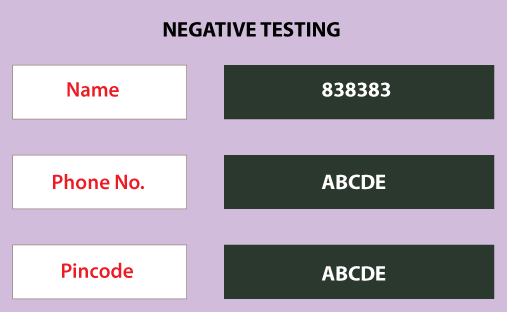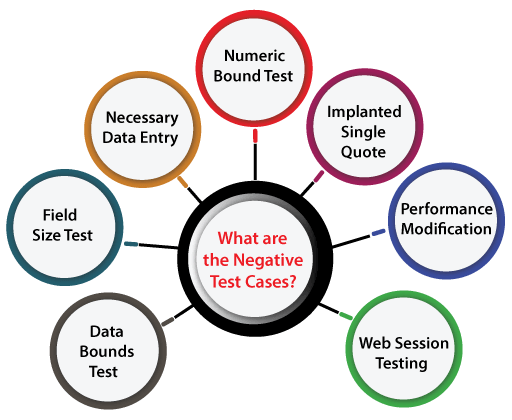Software testing is all about checking the application whether it is working according to the given requirement or not. We may have to use various software testing types like functional testing, Unit testing, Integration system, System testing, smoke testing, regression testing, and sanity testing to complete the process.
Software development is not an easy take to complete because it is all about writing extensive and complex codes and then testing these composite codes to guarantee faultless and constant performance. As we know, software testing is an essential aspect of writing a successful code.
However, all of these came into the following two categories, such as:
- Positive Testing
- Negative Testing
In this section, we are going to cover the following topics related to the particular testing technique known as negative testing:
- Introduction to negative testing and its purpose.
- Attributes of negative testing.
- Why do we need to perform negative testing?
- Examples of negative testing.
- Advantages and disadvantages of negative testing.
What is Negative Testing?
It is a unique type of software testing technique used to evaluate the system for unpredicted circumstances. It plays a very significant role in high-performance software development.
In this testing, the system is authorized by giving the invalid data as input. A negative test analyzed if an application performs as predictable with its negative inputs.

Mainly, negative testing is used to checks whether such unpredicted situations will be the software's performance.
In other words, we can say that negative testing is implemented to guarantee that the software product under test does NOT fail when an unpredicted input is given. It is also known as failure testing or error path testing.
The Objective of Negative Testing
- The primary objective of performing the Negative testing is to interrupt the system and validate the application response throughout the unexpected inputs.
- The execution of negative testing ensures suitable and ideal software performance even when the user performs inconsistently by inserting the invalid and wrong data.
- To make sure the constancy of the application against the impacts of different variations of inappropriate validation data set, we will implement the negative testing.
- It helps us to identify n-number of bugs and enhance the quality of the software application under test. However, the negative testing is done after the implementation of the positive testing.
Attributes of Negative Testing
Here, we are discussing some of the essential characteristics of negative testing, which are as follows:
- We can use negative testing to evaluate the potential security breaks and special handling procedures.
- Negative testing is used to analysis the application against the failed conditions.
- It is executed to break the system and achieve failure in a software product's functioning by feeding harmful data.
- It is performed to identify the defects which can result in essential breakdowns.
- Negative testing is executed to display data corruption or security violations.
- Usually, the aim of achieving the negative testing is being performed by a test engineer.
- In order to uncover the software vulnerability and potential for exploitation, we will execute negative testing.
- Negative testing is implemented to guarantee the stability of an application or the software product after being come across with the input values, outside the scope or limit, or invalid input data.
- It is implemented to find the critical loopholes or bugs and weak areas resulting in its failure.
Why do we need to perform the Negative Testing?
Subsequently, performing any type of testing activity is a cost and time-taking process. So, we have to select sensibly whether we need to implement the negative testing in our system or not.
Here, we are discussing why we need to perform negative testing in the particular application by considering the following preservatives of clients, organizations:

From Customer's point of view
- The Implemention of negation testing make sure to delivers a bug-free and zeroes vulnerability product in order to meet the Customer's expectation.
- Negative testing is needed when the application is crucial such as e-commerce, online stock, and so on.
- The cost is the only concern to the client while performing the negative testing. But when the effect is evaluated, it is up to the client to choose whether to perform negative testing or not.
From the company's point of view
- To deliver a good quality product to its customer is the responsibility of the organization. And to accomplish this, one has to perform negative testing.
- From a company's point of view, the negative testing needs to be performed because of validation against a failure.
- We should perform the negative testing because sometimes, we cannot guarantee to develop a 100% bug-free system, but we have to ensure that everything is done to avoid a failure.
- By performing the negative testing, we can also cover the vital cases of hacking since there are many hackers out there who are looking for a chance to destroy the system.
Example of Negative Testing
In negative testing, the software product's implementation is evaluated with the help of invalid data inputs. When unexpected parameters are entered, the response of the software is tested.
In such conditions, the application should display the following error message:
Invalid data input.
For example: Suppose we have one sample form to enter the values for the name, phone number, and Pincode fields. In such case, the negative input could be the following:
Name: 838383
(As the name field only accepts the alphabetic character value)
Phone No: ABCDE
(As the Phone no field only accepts the he values of the number)
Pincode: ABCDE
(As the Pincode field only accepts the he values of the number)

How to perform Negative Testing
To implement the negative testing, the test engineer needs to look out for all the possible scenarios. Specifically, if it is achievable, we have to think about it in the Test Case no matter whether it is not the right way to use it.
For example1:
Suppose we see an image upload option, so we have considered all probable inputs, and we can put there to test it with all possible files.
For example2:
Similarly, we have an email field, and we have to think about all possible inputs, and we can put them there other than the correct email format.
Note: In negative testing, we have to select the cases before implementation to save time and testing cost.
What is a Negative Test Case?
Another significant component of negative testing is Negative test cases. The team creates these negative test cases to test the application in a way where it is not meant to be used.
As we understood that the negative testing is performed to ensure the constancy and dependability of the application. And these should be measured by the team in the following testing efforts:
- Data Bounds Test
- Field Size Test
- Necessary Data Entry
- Numeric Bound Test
- Implanted Single Quote
- Performance Modification
- Web Session Testing

- Data Bounds Test
The testing team must test all the lower and upper bounds for data fields.
- Field Size Test
The functional specifications should specify the number of characters one can enter into a field. To ensure that this limit is not exceeded, we can write a test case.
It helps prevent users from incoming more characters before getting error messages after they have surpassed the limit.
- Necessary Data Entry
Each field in the software which involves data entry on the screen should be verified before the critical data is entered in the particular field.
- Numeric Bound Test
In order to make sure the negative test cases are accurate, the testing team needs to analyze both the lower and upper bounds.
- Implanted Single Quote
Some software systems come across an issue when the end-users try to store information containing a single quote.
Hence, for all the screens which receive alphanumeric data entry, the specific team should provide the text that involves one or more single quotes.
- Performance Modification
The test suite should contain test cases that compare previous and current release performance statics, which could help in categorizing potential performance problems.
- Web Session Testing
As we know that, various web applications vary on browser sessions to display several user information.
And the testing team prepares the test cases to release web pages within the application that don't involve users log in.
Negative Test Scenarios
The usage of negative testing enhances the test coverage of a software product or an application and finds the possible application failure in different conditions.
Following are some of the negative cases and test scenarios:
- Web Session Testing
- Inhabiting mandatory Fields
- Allowed number of special characters
- Consistency between Data Field Types
- Sufficient Data
Advantages of Negative Testing
Some of the significant benefits of negative testing are as discussed below:
- It will give more confidence to the client before going live.
- It enhances the possibility of covering all bases and each type of error, which can arise because of inconsistent human behavior.
- As we all understand, the implementation of negative testing is very significant to guarantee a product's quality because a good quality product or an application is considered as a zero-vulnerability product.
- It also ensures that all possible cases are covered during the execution of negative testing because, purposely or accidentally, there is a slight chance of negative test cases. Hence to ensure that all the test cases are covered, we have to perform one round of negative testing accompanied by positive testing.
Disadvantages of Negative Testing
However, the implementation of negative testing is helpful for an enhancement of an application, but there are still some drawbacks of negative testing, which are discussed below:
- The execution of negative testing needs unnecessary time, money, and effort.
- For the customer, it causes extreme delays in the software product or an application release.
- The implementation of negative testing needs a trained and experienced test engineer to develop negative test cases.
- In Software Testing, Negative testing in some cases becomes a time taking process. And in various circumstances, there is no need to execute excessive negative testing.
- Suppose, if the software is only developed for single-person use, then we don't have to think for a situation of 50-100 end-user using the application simultaneously. Therefore, in crucial cases, negative test cases are very significant. There will be times when we don't have to perform negative testing on a specific software product.
Overview
In this tutorial, we have understood the concept of negative testing. And after seeing all the relatable topics of negative testing, we can conclude that negative testing makes sure that the delivered software has no bugs and can be restrained in its usage by the customer.
To design the detailed and powerful negative test scenarios requires a creative, skilled, foresight, and intelligent test engineer.
As we know, each software development company desires to have capable and robust software that needs to undertake severe negative testing.
People often live under the delusion that Negative Testing is one more way of enhancing the expenditures without any possible benefits. This thought is significant as it can compromise the excellence of the final software product.
In the end, we can say that by implementing Negative Testing, we can enhance the quality of the software and make it stronger.



0 Comments